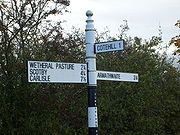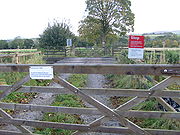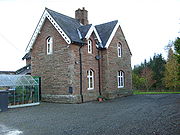
Cotehill railway station
Encyclopedia



Train station
A train station, also called a railroad station or railway station and often shortened to just station,"Station" is commonly understood to mean "train station" unless otherwise qualified. This is evident from dictionary entries e.g...
on the Settle-Carlisle Railway
Settle-Carlisle Railway
The Settle–Carlisle Line is a long main railway line in northern England. It is also known as the Settle and Carlisle. It is a part of the National Rail network and was constructed in the 1870s...
in England between Armathwaite
Armathwaite railway station
Armathwaite railway station is a railway station which serves the village of Armathwaite in Cumbria, England. It is operated by Northern Rail, which provides all passenger-train services. It is now, since the closure of Cotehill , Cumwhinton and Scotby stations, the final stop on the...
and Cumwhinton
Cumwhinton
Cumwhinton is a small village in Cumberland, England. It is around one mile away from both Scotby and Wetheral, and four miles from Carlisle. The village lies in Wetheral civil parish-History and facilities:...
. The line opened for passengers in 1876. The Ordnance Survey
Ordnance Survey
Ordnance Survey , an executive agency and non-ministerial government department of the Government of the United Kingdom, is the national mapping agency for Great Britain, producing maps of Great Britain , and one of the world's largest producers of maps.The name reflects its creation together with...
map published in the year 1900 shows the station serving the point at which a tramway from Knothill Plaster
Plaster
Plaster is a building material used for coating walls and ceilings. Plaster starts as a dry powder similar to mortar or cement and like those materials it is mixed with water to form a paste which liberates heat and then hardens. Unlike mortar and cement, plaster remains quite soft after setting,...
and Cement
Cement
In the most general sense of the word, a cement is a binder, a substance that sets and hardens independently, and can bind other materials together. The word "cement" traces to the Romans, who used the term opus caementicium to describe masonry resembling modern concrete that was made from crushed...
Works meets the Settle-Carlisle. The tramway continued from Knothill to Boaterby Quarry
Quarry
A quarry is a type of open-pit mine from which rock or minerals are extracted. Quarries are generally used for extracting building materials, such as dimension stone, construction aggregate, riprap, sand, and gravel. They are often collocated with concrete and asphalt plants due to the requirement...
. According to Tyler, Knothill was one of the first Gypsum
Gypsum
Gypsum is a very soft sulfate mineral composed of calcium sulfate dihydrate, with the chemical formula CaSO4·2H2O. It is found in alabaster, a decorative stone used in Ancient Egypt. It is the second softest mineral on the Mohs Hardness Scale...
sites in Cumbria
The station is named after the nearest village but this is 1.5 miles (2.4 km) away and extremely small. It is closer to Englethwaite Hall (now the location of a Caravan Club
Caravan Club
The Caravan Club is an organisation representing caravanners in the United Kingdom and the Republic of Ireland. It was founded in 1907 and now represents nearly 1 million members.-History:...
campsite) but it is clear from the map that the sparse local population could not have sustained a railway station. In addition, the station is only 3.5 miles (5.6 km) from Armathwaite and very close to Cumwhinton, both of which had stations of their own.
The tramway is absent from later maps, though its route is clearly visible as a track on the 1951 map. The station closed in 1952. Unusually for this line, the passenger buildings were demolished. The site remains clear so could in principle be re-used
Brownfield land
Brownfield sites are abandoned or underused industrial and commercial facilities available for re-use. Expansion or redevelopment of such a facility may be complicated by real or perceived environmental contaminations. Cf. Waste...
. One end of it is occupied by a communication mast
Antenna (radio)
An antenna is an electrical device which converts electric currents into radio waves, and vice versa. It is usually used with a radio transmitter or radio receiver...
. The stationmaster's
Station master
The station master was the person in charge of railway stations, in the United Kingdom and some other countries, before the modern age. He would manage the other station employees and would have responsibility for safety and the efficient running of the station...
house and railway workers' cottages are immediately adjacent to the Cotehill Viaduct
Viaduct
A viaduct is a bridge composed of several small spans. The term viaduct is derived from the Latin via for road and ducere to lead something. However, the Ancient Romans did not use that term per se; it is a modern derivation from an analogy with aqueduct. Like the Roman aqueducts, many early...
, where the railway crosses High Stand Gill
Gill (stream)
Ghyll or Gill is used for a stream or narrow valley in the North of England and other parts of the United Kingdom. The word originates from the Old Norse Gil...
near where it flows into the Eden
River Eden, Cumbria
The River Eden is a river that flows through Cumbria, England on its way to the Solway Firth.-Course of river:The Eden rises in Black Fell Moss, Mallerstang, on the high ground between High Seat, Yorkshire Dales and Hugh Seat. Here it forms the boundary between the counties of Cumbria and North...
. The houses are privately occupied.

